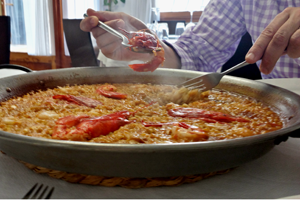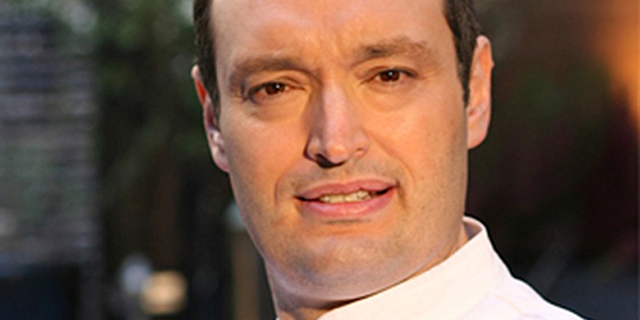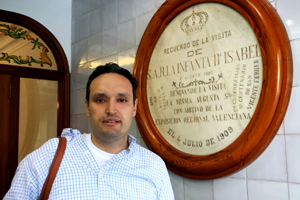Where does a Spanish chef spend his vacation? Spain, of course. When celebrated chef Luis Bollo, chef /partner of Salinas in New York City, decided to head back to Spain, he mixed a little business with pleasure. Instead of traveling back to San Sebastian, where he grew up, Bollo headed to Valencia to study, experiment, and try as much paella and rice as he could. Here, Esquire’s 2003 Chef of the Year, recalls his trip, shares what he can’t travel without, and his craziest travel experience.
Here’s what Bollo had to say about his travels:
I was born and raised in San Sebastian, Basque Country, which is in the north of Spain and adjacent to the French town, Bayonne. Before settling in the US, I lived and worked in Catalonia and Mallorca, learning a great deal about the traditional cuisine from the chef-driven restaurants in that region. But I had never visited Valencia before and was curious how “the land of the paella” cooked rice dishes. Since Salinas is about showcasing the flavors from the Spanish Mediterranean, I realized a visit to Valencia was overdue.
Paella is a thorny issue to tackle for many chefs coming from Spain, especially for those who were trained during the 1990s. This was a period of reinventing traditional dishes through the burgeoning trend of deconstructive, technical innovations. Since paella was considered to be a typical tourist food served on the Southern shores frequented by British and German tourists, there has always been pressure on many professional Spanish chefs to serve it at their restaurants. When I opened Meigas a decade ago in downtown NYC, I resisted including paella in the menu, which wasn’t taken well, nor understood by many people.
Spain has diverse traditions, languages, and climates. Going to Valencia for a Basque is like visiting New Orleans for a person who grew up in Maine. Instead of green trees, hilly mountains, and a cold breeze coming from the Atlantic ocean, Valencia’s landscape is one of color: almond and orange trees, miles and miles of land, comforting rays of long-lasting twilight, sun-drenched beaches with infinite skyline and the warm salt water of the Mediterranean. Valencia forces you to relax.
Next, Bollo heads to Valencia…
[pagebreak]Before the trip, I thought of paella like any other non-Valencian chef. I also knew that there was a transculturation of authentic paella abroad: in Valencia, paella is prepared either with seafood or with meat, never with both. So, we should say that paella mixta is a product of its internationalization.

First, I visited the birthplace of paella: El Palmar in the Albufera Region of Valencia. To get to this small town, you pass miles of rice patties as of you are in a Hollywood movie set in Vietnam in the late 60s. Instead of settling on one of dozens of popular restaurants serving paellas near the riverbank, I went to a back alley and found El Pascualet. Jose Pascual, a second-generation chef specializing on paella, was cooking a long repertoire of local delicacies here and I tried the most authentic version of paella.
I also visited many high-end restaurants like El Poblet, Vuelve Carolina, Mercatbar, Seu Xereu, Parallel, etc. to see how modern chefs interpret their rice tradition. After trying both traditional and modern renditions, I went to the Museum of Rice to learn about the history of rice in the region, which is located on El Cabanyal beach (I got sidetracked and enjoyed several hours of sunbathing).
What I learned from all these visits is that each village has a wide range of rice dishes prepared in many different ways and paella was just one of them. Besides its variety, as chef, what caught my eyes was that rice in Valencia is the star on the plate, not a dull backdrop served with abundant, more exciting seafood. Here seafood is the secondary element used to make broth while rice is the protagonist. The cooking point for rice is extremely important. Just as Italian pasta should be cooked al-dente, rice in Valencia is cooked al-dente and yet creamy.
Since returning from my trip, fully charged and inspired by my experiences in Valencia, I’ve been creating, testing, and entertaining friends to try my new rice dishes, which debuted in September.
Want to get a taste of Bollo’s recipe? Make your own!
- 8 tablespoons olive oil
- 7 ounces minced Spanish onion
- 7 ounces red bell pepper
- 3.5 ounces minced fresh tomatoes
- 3.5 ounces chopped cuttlefish
- 3.5 ounces peeled rock shrimp
- 3.5 ounces chanterelles
- 1 tablespoon sweet smoked Spanish paprika
- 1 pinch saffron
- 12 ounces Bomba rice
Want to know more about how Bollo travels? Check out our Travel Q&A.
[pagebreak]What five essential items are always in your travel bag?
Tons of underwear, two pairs of New Balance, an international voltage converter, a phone charger, and my Samsung Galaxy.
Do you have any rituals or superstitions?
Ever since a friend told me it’s safer to travel in the back of the airplane, I prefer being seated in the back area. I’m not sure if it’s scientifically proven. Although I don’t go to church, I make a cross before the plane takes off. It’s one of the few Catholic traditions I keep.
What’s the one home-cooked meal that you crave on the road?
Nothing really. I am always eager to try local foods wherever I go. It’s more exciting to learn about what people eat in other parts of the world. I know my wife brings a little spicy red bean paste (go chu jang) to add Korean flavors, if needed. But there’s nothing I crave when I’m on the road.
What’s been your best travel experience ever?
In 2003, I took two weeks off to visit the best restaurants in Spain. I went to eat at El Bulli, Azrak, Martin Berasategui, and Suberoa. Since I worked for Martin Berasategui before coming to the US, I went to visit him again to see how things have changed since I left. I also knew Arzak and Suberoa personally. But it was my first time meeting Ferran Adria and I wanted to take a picture with him. But, I forgot to bring my camera. It was when I didn’t have a smart phone or a digital camera.
What’s your craziest travel story?
In 1980, my parents took us to Portugal for vacation. We went with another family with two children who were friends of my parents. It was the time when all European countries had customs and strict border control. After driving 7 hours from San Sebastian to the Portuguese border, my parents realized they didn’t bring our passports. In order to not ruin the vacation from the beginning, they borrowed the passports from the family who was traveling with us. The funniest part of it, is that my sister had to pretend she was a boy since the children of the other family were two boys. We were lucky there were a lot of people and the custom personnel didn’t have time to check carefully.




![Making Mealtime Matter with La Familia: Easy Sofrito [Video]](https://thelatinkitchen.com/wp-content/uploads/2015/10/sofrito-shutterstock__0-500x383.jpg)
![Easy Latin Smoothies: Goji Berry Smoothie [Video]](https://thelatinkitchen.com/wp-content/uploads/2015/12/goji_berry-shutterstock_-500x383.jpg)
















![Fun and Fast Recipes: Fiesta Cabbage Salad [Video]](https://thelatinkitchen.com/wp-content/uploads/2015/11/fiesta_cabbage_slaw-shutterstock_-500x383.jpg)









